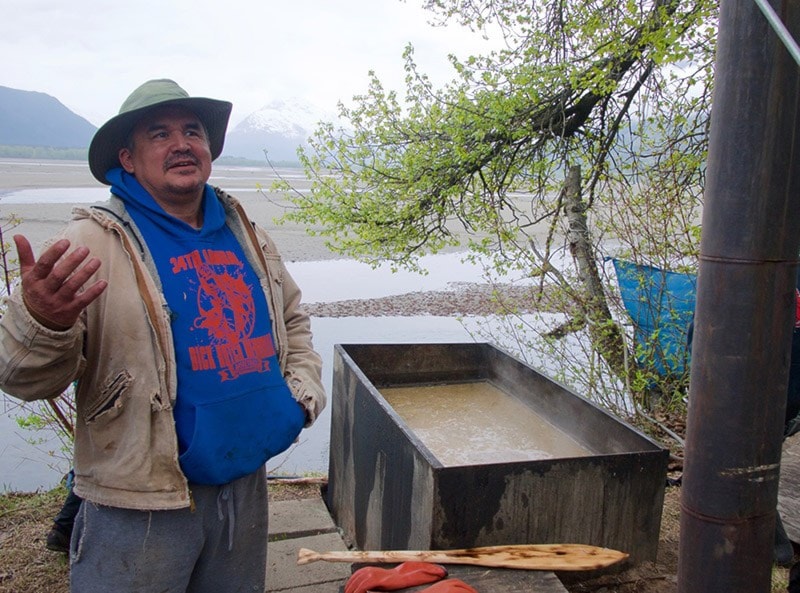Miche Genest
Special to the News
Eulachon, a small oily member of the smelt family, has many different names, including hooligan, oolichan and candlefish. You can thread a wick through the mouth of a dried eulachon, light it and it’s so full of oil it will burn just like a candle.
For thousands of years this fish has sustained First Nations peoples in the Pacific Northwest. The oil was a major trading item between coastal and inland First Nations, so much so that the trade routes from fisheries to the interior and back are known as “grease trails.”
The Dalton Trail was originally a grease trail; a Chilkat trading route that started in Klukwan on the Chilkat River and ended at Five Finger Rapids on the Yukon River just north of Carmacks. Coastal peoples traded eulachon oil in exchange for furs, copper, and hides from interior Yukon First Nations.
Today, eulachon oil is still a popular trade item, as Duane Wilson will tell you. Wilson fishes hooligan in the Chilkoot River near Haines, Alaska (where they’re called hooligan), and then renders the oil in a small fish camp on the banks of the Chilkat, along the old trading route. “Trading is fun,” he says. “You meet people.” He trades his oil for black seaweed, which doesn’t grow near Haines, and deer meat, also rare, from Alaskan towns further south, such as Kake, Sitka and Ketchikan, where the hooligan don’t run.
In Alaskan households hooligan oil is an important staple. The oil is semi-solid at room temperature, with a texture like soft butter. “We use it on baked potatoes, and we take it for our health,” says Wilson. He used to take half a teaspoon a day, but now he’s up to a tablespoon. “The oil is good for everything” he says. “Full of vitamin A.”
Wilson’s fish camp is an example of simple, old technology at work. He welcomed a group of Canadian visitors early in May, just when the run was ending, and explained the whole process to them.
He ferments the fresh hooligan—this year, three truckloads—in a wood-lined locker dug into the earth. (In the very old days the fish were fermented in a canoe half-buried in the sand.) “The important thing is the consistent temperature,” he says. At the bottom of the locker is a quarter-inch screen topped by a layer of grass. The fish are loaded in and the locker screwed shut. “No peekaboos,” says Wilson. “I used to peekaboo but not anymore.” Patience, he says, is a good thing.
The fish take about 10 days to ferment, though just up the road in Klukwan, where the soil is darker because of the iron content, the fish ferment much faster. Fermentation breaks down the meat, making it easier to extract the oil in the rendering process.
The rendering, too, uses simple, efficient technology. A vat with a holding capacity of more than 550 litres is set in the riverbank above a fire pit dug into the bank. A stovepipe sunk into the earth provides ventilation for the fire. When it’s time to render, Wilson and his helpers fill the vat with water and light the fire underneath. The hooligan are poured in once the water is boiling, and the mixture reduced to a simmer.
Every now and then a large bubble erupts on the surface — what Wilson calls a “boil up.” Periodically Wilson or a helper runs a small, carved oar through the water and brings a few fish up to the surface, hanging off the oar. “We tap the oar lightly on the side of the vat so that the flesh falls off the bone,” Wilson says, and that helps speed up the rendering. Once in a while somebody sprinkles cold water from a watering can over the surface to drive the scum down to the bottom, where it stays.
When the fish have simmered long enough and it’s time to separate out the oil — “You just know when,” says Wilson — he takes a piece of curved plywood somewhat wider than the vat. The plywood is inserted into the vat at one end and pushed slowly towards the other, and as it’s pushed the oil gathers at that end. From there it’s poured through a filter, like the ones used in restaurants for filtering oil from deep fat fryers, into buckets. Finally the oil is decanted into quart jars, sealed and turned upside down, and the cooling oil activates the vacuum seal.
The process takes about a day from start to finish, and three truckloads takes several days, rendering in batches. The meat and bones feed the trout in the river. “Those trout get fat,” says Wilson. “But I don’t know if they start to taste like hooligan.”
One year Wilson’s family filled the whole locker with the fish harvested in one tide. “But that was a very long time ago, when I was a kid,” he says. Though hooligan are still abundant in marine waters near Alaska and Northern B.C., they’ve disappeared from California and are significantly reduced in number in B.C. rivers.
The Committee on the Status of Endangered Wildlife in Canada (COSEWIC) assessed the Nass-Skeena population as of special concern and the Central Pacific and Fraser population as endangered. In B.C. the commercial eulachon industry is closed, recreational net fishing in rivers is prohibited and so is the recreational tidal harvest. Many First Nations fisheries have closed down as well.
The small group of Canadian visitors who visited Duane Wilson’s fish camp felt lucky to witness the ancient practice of rendering hooligan oil. Wilson feels lucky too. He learned what he knows from his uncles; they taught him the importance of preserving the fish for future generations, and for feeding present-day elders. Wilson quotes one of his uncles. “He said, ‘take care of the elder that you will become.’” In other words, take care of the eulachon.
Miche Genest is a chef and writer based in Whitehorse.
